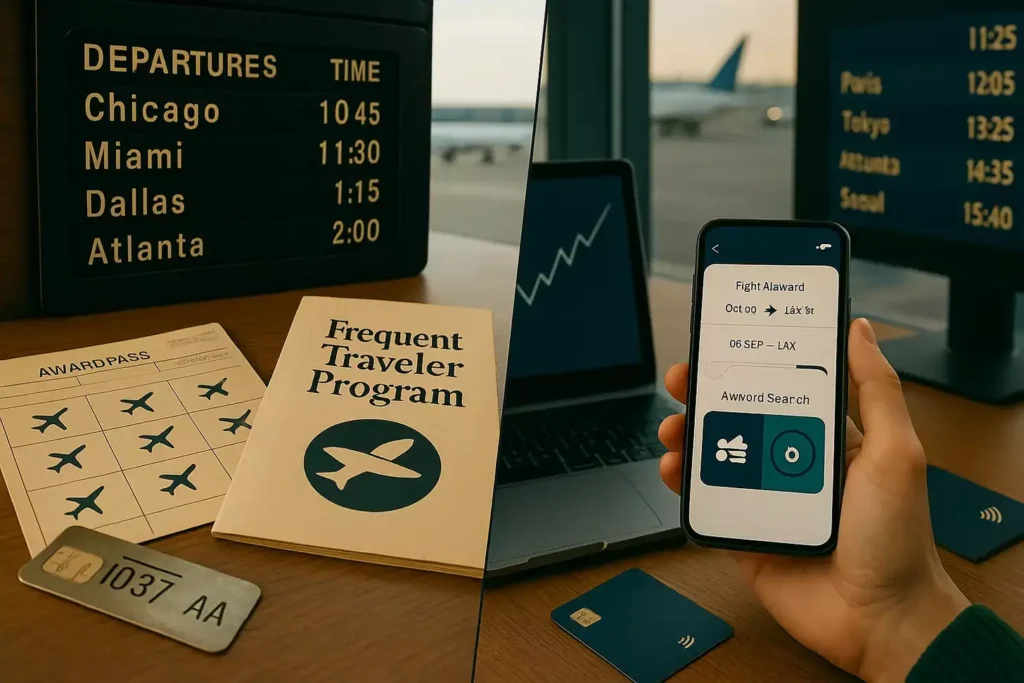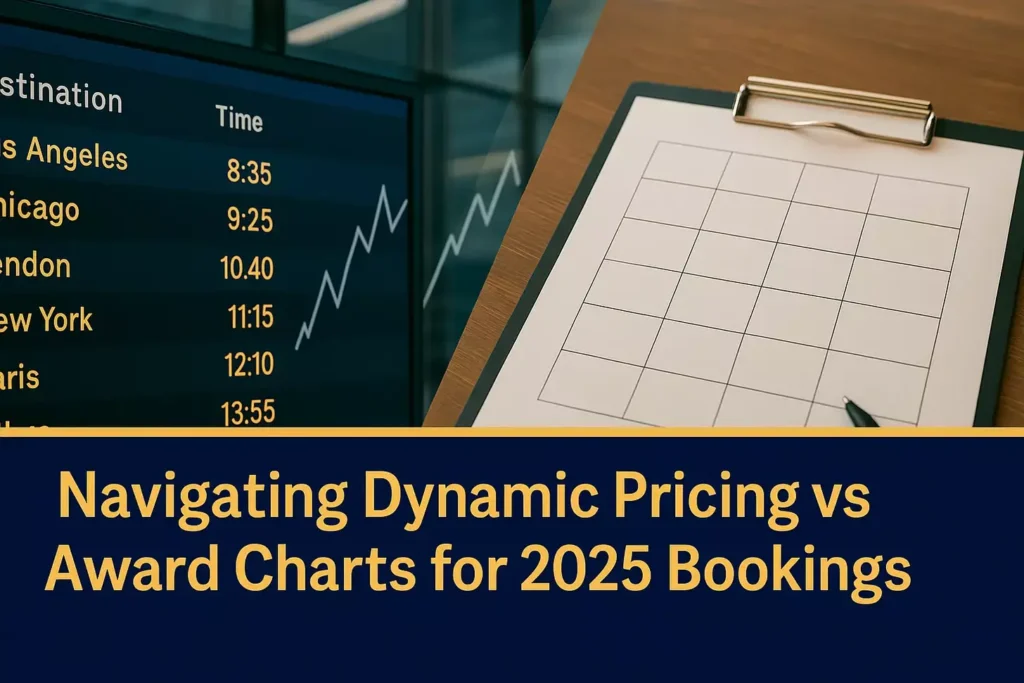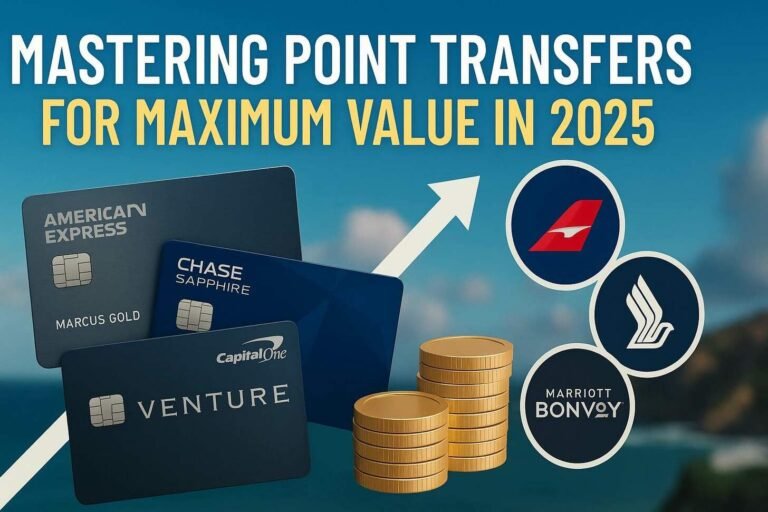Affiliate Disclosure: Award Travel Hub may earn a commission or referral bonus from some links on this site. These affiliate links help support our work and may influence the placement or promotion of certain products or services. However, our content is independently crafted to reflect honest opinions. Not all offers or products are included. There is no additional cost to users when they utilize our affiliate links.
What if the playbook you’ve used for years to book flights with your hard-earned miles is now obsolete?
Since the birth of the first frequent flyer program, travelers have relied on predictable systems. Award charts acted as a clear rulebook. They told you exactly how many points a flight would cost. But the ground has shifted dramatically.
Today, most major carriers have moved to a different model. Flight costs using miles now change with demand. This creates a landscape filled with both risk and opportunity. For anyone looking to maximize their loyalty program benefits, understanding this split is no longer optional—it’s essential.
We’ve done the deep analysis to cut through the complexity. This guide is your survival toolkit. We’ll show you how to find incredible value, even when the rules seem to change overnight.
Key Takeaways
- The fundamental shift from fixed-price award charts to demand-based pricing models.
- Why is this knowledge critical for getting maximum value from your points and miles?
- How the strategies that worked for years are being rewritten in real-time.
- Where to find hidden opportunities within this new, more complex system.
- The specific airlines that use each type of pricing model.
- Actionable tactics you can use immediately for your next redemption.
Understanding Award Charts and Dynamic Pricing
The foundation of smart travel planning begins with grasping the core systems that govern how your points translate into flights. We’re starting with clear definitions because understanding this fundamental difference is essential before developing practical booking approaches.
Defining Award Charts
Traditional award charts function as published price lists for your miles. They show exactly how many points a specific route will cost, giving you a concrete savings goal.
These charts typically categorize flights using geographic zones or distance bands. A business class flight from North America to Europe might always cost the same number of miles, regardless of when you book. This predictability allows for confident planning months or even years in advance.

How Dynamic Pricing Transforms Redemptions
The newer model flips this approach entirely. Here, your miles cost ties directly to the cash ticket price. The same seat on the same flight could cost significantly different amounts depending on demand.
Airlines claim this increases award seat availability since they’re not restricting inventory to protect fixed-price awards. However, the transparency trade-off is significant. Without published charts, you have no way to know if you’re getting good value until you search.
This transformation represents a shift from viewing loyalty programs as customer rewards to treating them as sophisticated revenue management tools. Neither system is inherently better—each has advantages that smart travelers can leverage.
Evolution of Frequent Flyer Programs and Award Systems
Four decades of evolution have completely rewritten the rules governing how frequent travelers convert their loyalty into tangible rewards. The journey from American Airlines’ 1981 AAdvantage launch to today’s complex systems reveals a dramatic shift in philosophy.
Historical Perspective on Award Charts
In the early days, frequent flyer programs operated on simple principles. Travelers earned miles and redeemed them using published award charts that guaranteed predictable pricing.
This created trust between airlines and their loyal customers. For nearly thirty years, these fixed-rate systems remained stable across most major carriers.

The Shift to Dynamic Award Pricing
The 2010s marked a turning point. Carriers discovered their loyalty programs had immense financial value beyond customer retention.
Delta’s 2015 move to eliminate its chart signaled an industry-wide transformation. Airlines began treating miles as controllable currency rather than customer rewards.
| Feature | Traditional Programs | Modern Systems |
|---|---|---|
| Pricing Model | Fixed award charts | Demand-based algorithms |
| Predictability | High – published rates | Low – fluctuates daily |
| Sweet Spots | Consistent opportunities | Rare and temporary |
| Customer Trust | Built on transparency | Challenged by complexity |
This evolution represents a fundamental change in how airlines view their most loyal passengers. The predictable value once guaranteed by fixed award charts has been replaced by revenue-focused systems.
The Fundamentals of Award Charts
Understanding how traditional award charts function reveals strategic advantages that casual travelers often overlook. These fixed-rate systems operate on clear principles that, when appropriately mastered, can dramatically increase your redemption value.
Zone-Based and Distance-Based Models
Zone-based award charts categorize countries into geographic regions. The magic happens when you realize all routes within a zone pairing cost the same number of miles. This creates famous “sweet spots” where long journeys cost the same number of points as shorter flights.
Distance-based models calculate costs using actual flight mileage. Airlines like British Airways use this approach. It makes short regional flight redemptions remarkably affordable. However, multi-stop itineraries can become expensive as each segment’s distance adds up.
Pros and Cons of Traditional Award Charts
The inherent predictability of published charts allows confident trip planning years in advance. You know precisely how many miles you need to save. The price won’t suddenly double next month.
However, traditional systems have limitations. Airlines restrict award seat availability at standard rates. You might see plenty of cash seats but zero award inventory. These programs require flexibility, as premium-class availability can be scarce during peak periods.
Despite these challenges, fixed award charts provide transparency that modern systems lack. Strategic travelers can still find incredible value by understanding these fundamental mechanics.
Transitioning to Dynamic Pricing in 2025
We are now witnessing the full-scale implementation of a new industry standard. This year represents a tipping point where real-time cost adjustments have moved from an exception to the norm. Major carriers across all global alliances have fully embraced this approach.
United, American, and Delta—the three largest U.S. airlines—now all employ these systems. This coordinated shift means algorithms, not published charts, govern the majority of domestic and transatlantic capacity.
Factors Driving the Change
Carriers adopted these models to maximize revenue. Robust systems analyze demand in real-time. This prevents “losing” revenue on high-value seats.
The goal is to align the cost of a reward seat with its cash value. This also eliminates the famous “sweet spots” that savvy travelers once exploited. Airlines claim it increases availability, but the reality for members is often more complex.
Impact on Traveler Strategies
The old strategy of saving toward a fixed mileage goal is obsolete. The price for a flight can change dramatically between saving and booking. This demands a new set of skills for success.
Flexibility and speed become more critical than simply having a large point balance. Technology tools are essential for spotting value. While peak costs can be high, last-minute deals can sometimes offer unprecedented value.
| Driver | Airline Benefit | Traveler Impact |
|---|---|---|
| Revenue Maximization | Aligns the award cost with the cash price | Less predictable redemption value |
| Advanced Technology | Real-time inventory and price adjustment | Need for constant price monitoring |
| Elimination of Sweet Spots | Closes perceived loopholes | Loss of consistent high-value opportunities |
Dynamic Pricing vs Award Charts: Booking Strategy for 2025
Your journey to mastering loyalty programs now hinges on a critical strategic choice. We’re moving beyond theory into the practical framework that delivers real results. Success depends on adapting your mindset and methods.
Tactics for Maximizing Value
Flexibility is your new superpower. Shifting your travel dates by just a few days can slash the required miles by half. This simple adjustment dramatically increases the availability of award seats and improves your redemption value.
We advocate for a “book now, optimize later” strategy. Secure a reasonable award flight when you find it. Then, monitor for price drops. Many programs allow free cancellations, letting you rebook at a lower cost.
Always comparison shop. Check multiple airlines and partner programs for the same route. One might use a fixed-rate system, while another employs fluctuating pricing. This ensures you find the best deal for your points.
Choosing the Right Redemption Approach
Your first decision involves where to accumulate your points. Airline-specific miles can offer great value. However, transferable bank points provide crucial flexibility to shop across different programs.
Think in terms of cents per point value. A high-mileage cost for a premium cabin flight can still be an excellent redemption if it replaces an expensive cash ticket. This mindset helps you assess true worth beyond the raw number of miles.
Ultimately, the savvy traveler leverages both systems. Use fixed charts for predictable, long-term planning. Utilize the new model for last-minute deals and flexible itineraries. This balanced approach maximizes every mile you earn.
Leveraging Loyalty Programs in the New Era
The modern era of airline loyalty presents a fascinating paradox for strategic members. While elite status becomes easier to earn through credit card spending, its traditional benefits have transformed significantly.
Today’s frequent flyer programs heavily reward co-branded card usage. American’s AAdvantage and Delta’s SkyMiles now prioritize spending over flying for status attainment. This creates accessibility but dilutes the exclusive value once associated with high-tier status.
Elite Status Benefits and Frequent Flyer Programs
The real advantage of elite status now lies in incremental perks rather than dramatic award pricing benefits. You’ll enjoy priority boarding, waived fees, and occasional upgrades. However, don’t expect significantly better award availability on your primary carrier’s flights.
Airlines aggressively compete for your loyalty through status match offers. These programs let you test-drive competing loyalty programs without starting from zero. This creates unprecedented flexibility for strategic travelers.
Partner Award Opportunities Explained
Many programs maintain fixed charts for partner award redemptions while using variable pricing for their own flights. This creates valuable arbitrage opportunities. Booking United flights through Air Canada Aeroplan often yields predictable pricing when direct bookings would cost more.
Credit card partnerships offer built-in discounts that partially offset variable pricing. Most Delta American Express cards provide 15% off Delta-operated award tickets. Similar benefits exist across popular United credit cards.
| Feature | Partner Booking | Direct Booking |
|---|---|---|
| Pricing Model | Often fixed charts | Typically variable |
| Predictability | High – known rates | Low – fluctuates |
| Sweet Spots | Consistent opportunities | Rare and temporary |
| Cardholder Benefits | Limited discounts | Built-in savings |
The key insight involves diversification across multiple programs. Maintain balances in transferable point systems alongside airline-specific miles. This flexibility lets you exploit the best value for each redemption.
Navigating Airline Mergers and Dynamic Alliances
The airline industry is undergoing its most dramatic restructuring in over a decade, reshaping how travelers earn and redeem their rewards. Four major consolidations are simultaneously redrawing alliance maps and forcing strategic decisions.
We’re tracking unprecedented changes that affect millions of loyalty program members. The Alaska-Hawaiian merger creates oneworld’s first major consolidation. Air France-KLM’s acquisition of SAS moves a generous program from Star Alliance to SkyTeam.
The Impact of Consolidations on Loyalty Programs
These structural shifts create both threats and opportunities for travelers. When airlines merge, their loyalty programs often consolidate too. This means your preferred program could be eliminated or fundamentally altered.
The Lufthansa-ITA merger is likely to end distinct ITA Volare benefits, folding members into Miles & More. Korean Air’s Asiana merger represents Asia’s most significant aviation consolidation, transitioning millions to SKYPASS.
This merger wave makes maintaining points in multiple programs more critical than ever. Your primary airline loyalty program might cease to exist within 12-18 months. The old advice to “pick one airline and stick with it” no longer applies when the airline itself could be absorbed or shifted to a different alliance.
Strategic travelers should diversify their mileage balances across transferable point systems and multiple airline programs. This flexibility lets you take advantage of the best value as the landscape continues to evolve.
Tools and Strategies to Beat Dynamic Pricing
In today’s rapidly changing loyalty landscape, technology has become your most powerful ally for securing the best redemption values. We’ve moved beyond manual searches to intelligent platforms that level the playing field.
Manual checking of multiple airline websites is no longer practical. The speed of cost changes demands equally fast response tools.
How AwardFares Enhances Your Search
AwardFares transforms the search process by aggregating real-time availability across 14 major frequent flyer programs. You can compare routes and redemption options from over 50 airlines in seconds.
The platform’s Timeline View shows costs across an entire month at a glance. This makes it obvious which dates offer the best value for your points.
You get detailed flight information, including seat maps for premium cabins. Powerful filters let you narrow searches by airline, cabin class, and number of stops.
Using Technology for Real-Time Comparisons
The comparison feature reveals situations where one program charges 70,000 miles while a partner offers identical seats for 45,000. This side-by-side view is crucial for maximizing value.
Alert functionality becomes essential when award space changes constantly. Set your ideal route and price point, then get notified instantly when availability appears.
Historical data analysis helps you understand booking patterns. You’ll learn when routes typically release award space or which days consistently offer lower mileage costs.
Case Studies: American Airlines AAdvantage and Beyond
Case studies from American Airlines demonstrate the real-world application of modern pricing systems. We chose American Airlines AAdvantage because its transition from fixed charts to demand-based models aligns with industry trends.
Consider a business class flight to Paris. During winter’s low demand, you might pay just 78,000 miles. The same summer flight could cost over 150,000 points.
This represents a significant change from pre-2022. Back then, the fixed chart priced all North America-Europe business class at 57,500 miles.
Real-World Examples of Dynamic Pricing
We calculate value using cents per mile. If that winter flight replaces a $3,000 ticket, you get excellent value at 3.8 cents per point.
Seasonal flexibility becomes crucial. Shifting a July trip to November can save enough miles for an additional round-trip.
American Airlines AAdvantage also reveals partner opportunities. Booking the same flight through British Airways might yield fixed pricing, while direct booking shows variable rates.
| Carrier | Winter Business Class (miles) | Summer Business Class (miles) |
|---|---|---|
| American Airlines | 78,000 | 150,000+ |
| Delta Air Lines | 70,000 | 140,000 |
| United Airlines | 75,000 | 160,000 |
The key lesson? Timing and flexibility now determine value more than simply accumulating a target mile balance.
Planning Your 2025 Travel with Confidence
True travel confidence emerges when you stop fighting the system and start working with its new realities. We’re building your comprehensive framework that turns industry changes into personal advantages.
Your most powerful tool is flexible date searching. Instead of locking into specific days, scan entire months using calendar views. This reveals pricing patterns that are invisible in day-to-day searches.
Flexible Date and Route Strategies
We teach the “bookend” approach. Secure seats when inventory first opens at 11 months out. Also watch for last-minute releases when airlines drop unsold premium cabin seats.
Maintain a portfolio of points across multiple currencies. This includes transferable bank programs and a couple of airline-specific balances. Diversification gives you options when one program’s price is too high.
| Approach | Best For | Potential Savings |
|---|---|---|
| Early Booking (11 months) | Fixed itineraries | 30-50% mileage discount |
| Last-Minute Search (1-2 weeks) | Spontaneous travelers | Premium cabin deals |
| Shoulder Season Travel | Date-flexible planners | Consistent lower pricing |
Optimizing Award Redemptions Effectively
Use your miles regularly for solid value instead of hoarding them. The risk of devaluation now outweighs waiting for perfect redemptions. Consider economy flights to save cash for other trip expenses.
Many programs offer free cancellations on award tickets. Book at a decent price, then set alerts for potential drops. You can rebook if availability improves.
This multi-layered approach builds genuine confidence. You’ll know you have backup dates, alternative programs, and monitoring systems working for you.
Future Trends in Airline Pricing and Loyalty Programs
Tomorrow’s loyalty ecosystem will feature instant gratification and personalized offers. New costs and privacy considerations will also demand our attention.
Technological Innovations on the Horizon
Instant miles posting transforms points into flexible currency. You can earn miles on your outbound flight and potentially use them for upgrades during the same trip.
Artificial intelligence delivers hyper-personalized offers based on your travel history. These smart systems calculate upgrade prices specifically for your spending patterns.
Biometric technology streamlines airport check-in using facial recognition. This convenience comes with important privacy considerations about data retention.
Regulatory Changes and Market Shifts
The U.S. Department of Transportation launched a formal inquiry into major carrier programs. This scrutiny focuses on transparency issues and sudden mileage devaluations.
Environmental surcharges are becoming permanent additions to ticket costs. Lufthansa’s € 72-per-flight fee will likely become an industry standard.
We’re also seeing the rise of “unbundled business class” fares. These offer lie-flat seats without premium amenities, creating new revenue tiers.
Buy Now, Pay Later options make expensive premium tickets more accessible. This flexibility helps travelers manage costs but requires careful budgeting.
Practical Tips for Handling Dynamic Award Pricing Surges
When you encounter unexpectedly high redemption costs, having a clear action plan can transform frustration into opportunity. We’ve developed a systematic approach for those moments when the number of miles required seems unreasonable.
Maximizing Points and Miles Value
Your first move should always be to be flexible. Expand your search window by several days in each direction. Shifting your travel dates slightly often reveals dramatically different pricing.
Partner programs become your secret weapon during price surges. If one airline shows high costs, immediately check if the same flight is available through their partners at fixed rates. This simple switch can save thousands of points.
We teach travelers to calculate value in real-time. Divide the cash price by the required number of miles. Aim for at least 1.5 cents per point to ensure you’re getting reasonable value for your hard-earned rewards.
Sometimes the best strategy is walking away. If the redemption offers poor value, preserve your points for better opportunities. Treat your miles as investments that should generate solid returns.
Consider mixing one-way redemptions with cash tickets. Dynamic systems often price outbound and return flights differently. This approach lets you optimize each segment separately.
The psychological shift is crucial. Move from “I have miles, so I should use them” to “This redemption delivers measurable value.” This mindset protects your points from poor-value redemptions.
Conclusion
Mastering modern award travel requires embracing change rather than resisting it. We’ve explored the complete shift from fixed award charts to dynamic pricing, the most significant evolution in four decades.
The landscape is more complex, but the opportunity for incredible value remains. Success now hinges on new skills: flexibility with travel dates, a diversified portfolio of points and miles, and smart tools for quick comparisons.
No single system is perfect. The savvy approach leverages the strengths of each model. This means using fixed-rate partner programs for predictability and demand-based systems for last-minute deals.
With the right knowledge, you can confidently navigate this new era. Your loyalty and hard-earned points will continue to unlock amazing flights and experiences.






